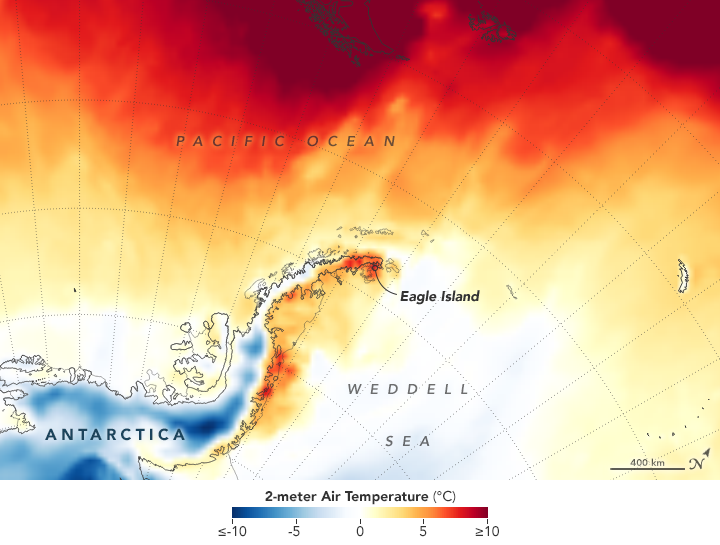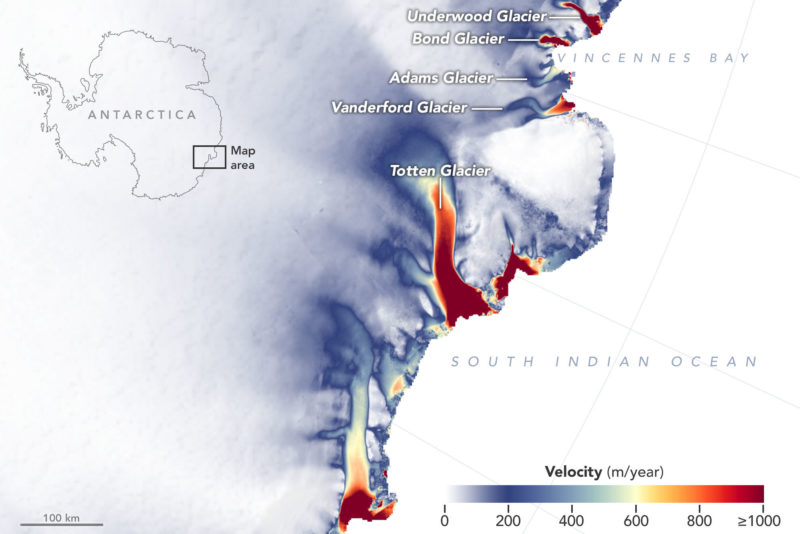Antarctica’s ice sheet is unstable in the west and stable in the east. Or so we thought. Recent observations have shown accelerating melting trends on the eastern shores, which contain the vast majority of the continent’s ice volume.
Earth.Org takes a closer look.
—
Antarctica, home to the South Pole, is the coldest place on earth. Nearly twice the size of Australia, 95% of its surface is covered by a thick ice sheet containing 26.5 million cubic kilometers of ice. This represents around 90% of our planet’s ice, or 61% of all freshwater, which translates to 57.2 m of potential sea level rise.
Temperatures usually hover around -55°C, with lower extremes near -100°C but the continent hit its highest temperature on record on February 6, 2020, at 18.3°C. People in Los Angeles were experiencing the same temperature on that day.

Surface air temperature around the Antarctic Peninsula during the February 2020 heatwave. Source: NASA GEOS.
Most of Antarctica’s ice loss is due to quicker glacier flow in areas close to warm, salty water. It was long established that West Antarctica was the major source of ice melt, while East Antarctica’s snowfall and stability made up for it, maintaining the ice sheet in equilibrium. Unfortunately, East Antarctica is now melting.
A controversial paper in 2019 states that the continent has been shrinking for some time now, and this is accelerating. They were able to reconstruct Antarctica’s decadal ice melt rates since 1979.

To the left: Ocean temperatures around Antarctica. To the right: ice discharge change for 18 major sub-regions for 1979-2017; percentage change in color, ball size proportional to change. Source: Rignot et al. 2019.
The figure above shows how continent-adjacent high ocean temperatures coincide with higher ice loss locations. The smaller eastern ice discharge areas are the biggest source of worry as they have only recently begun accelerating their inexorable slide toward the ocean.

Annual ice loss around the Wilkes Land coast in East Antarctica. The four northern-most glaciers have lost around 3 m surface height since 2008. Source: NASA Earth Observatory, Joshua Stevens.
In summary, as oceans warm, adjacent ice melts faster, which in turn accelerates glacier flow, thus increasing the amount of water-adjacent ice. This feedback loop is worrying as it remains unclear how far the acceleration could go. In light of these recent developments, scientific consensus describes a possible 6 feet of sea level rise by the end of the century, but Eric Rignot, studying ice sheet dynamics from the University of California, says it could reach 13 feet per century.
If this were to occur, places like the southern tip of Florida, massive agglomerations in China and Indonesia, and the Pacific Island states could be fully submerged (for more on this, check out our Sea Level Rise by 2100 series).
With only ocean temperatures, snowfall measurements and a few decades of satellite data to go on, scientists have not yet fully understood what is happening with the Antarctic’s ice sheet. One thing is clear however, it is not in equilibrium anymore.
This article was written by Owen Mulhern.
You might also like: Antarctica Melt is Unavoidable, Regardless of Climate Action
References
-
Rignot, Eric, et al. “Four decades of Antarctic Ice Sheet mass balance from 1979–2017.” Proceedings of the National Academy of Sciences 116.4 (2019): 1095-1103.
-
NASA Earth Observatory / Joshua Stevens










![The Statistics of Biodiversity Loss [2020 WWF Report]](https://u4d2z7k9.rocketcdn.me/wp-content/uploads/2020/12/lprwinkyTHB-544x306.jpg)





